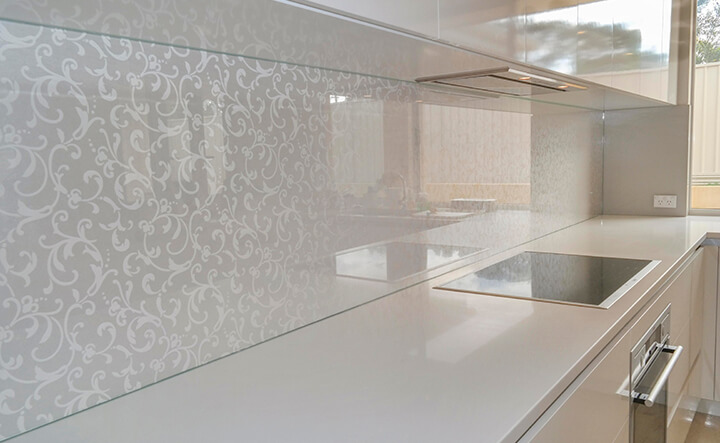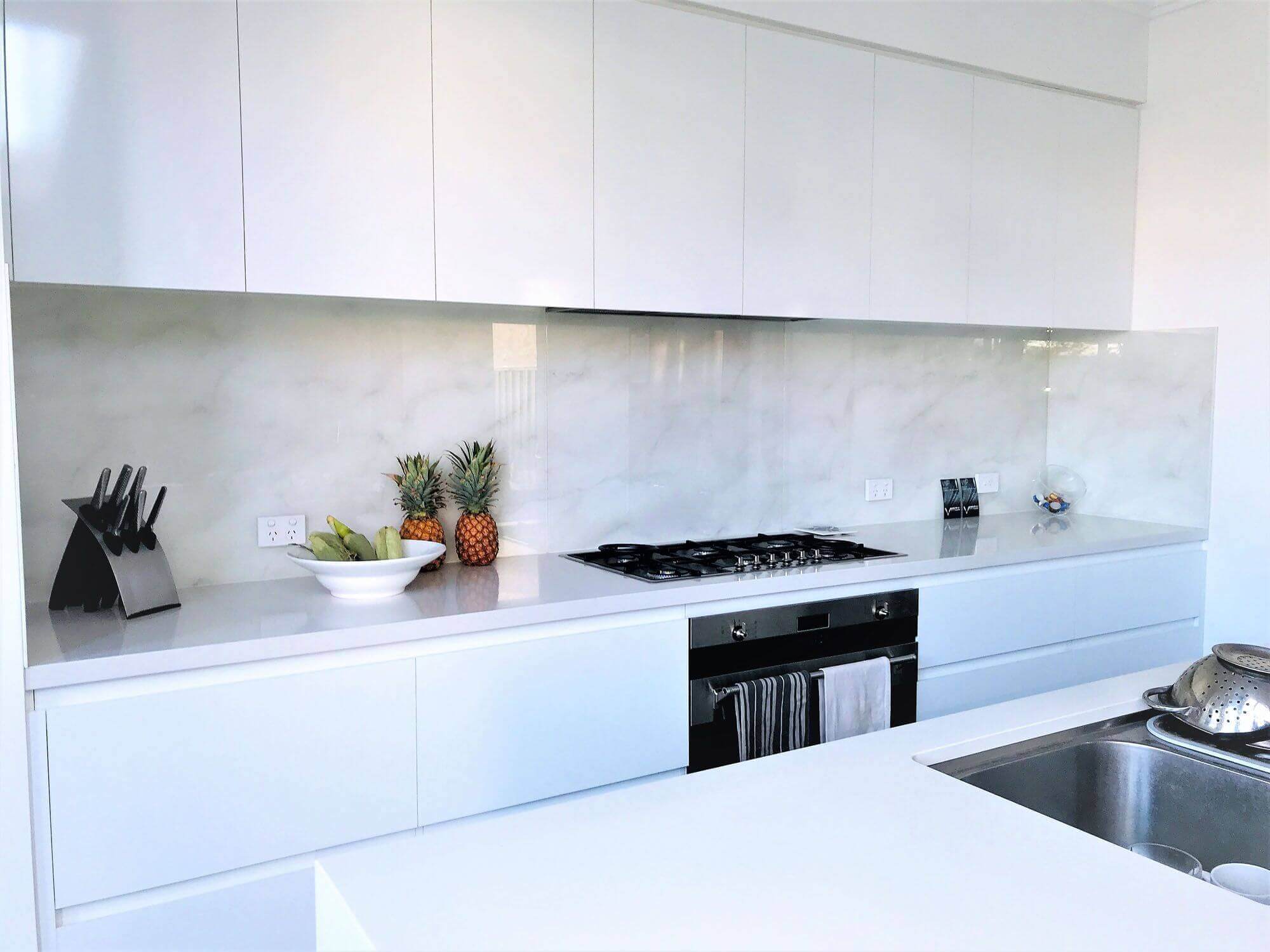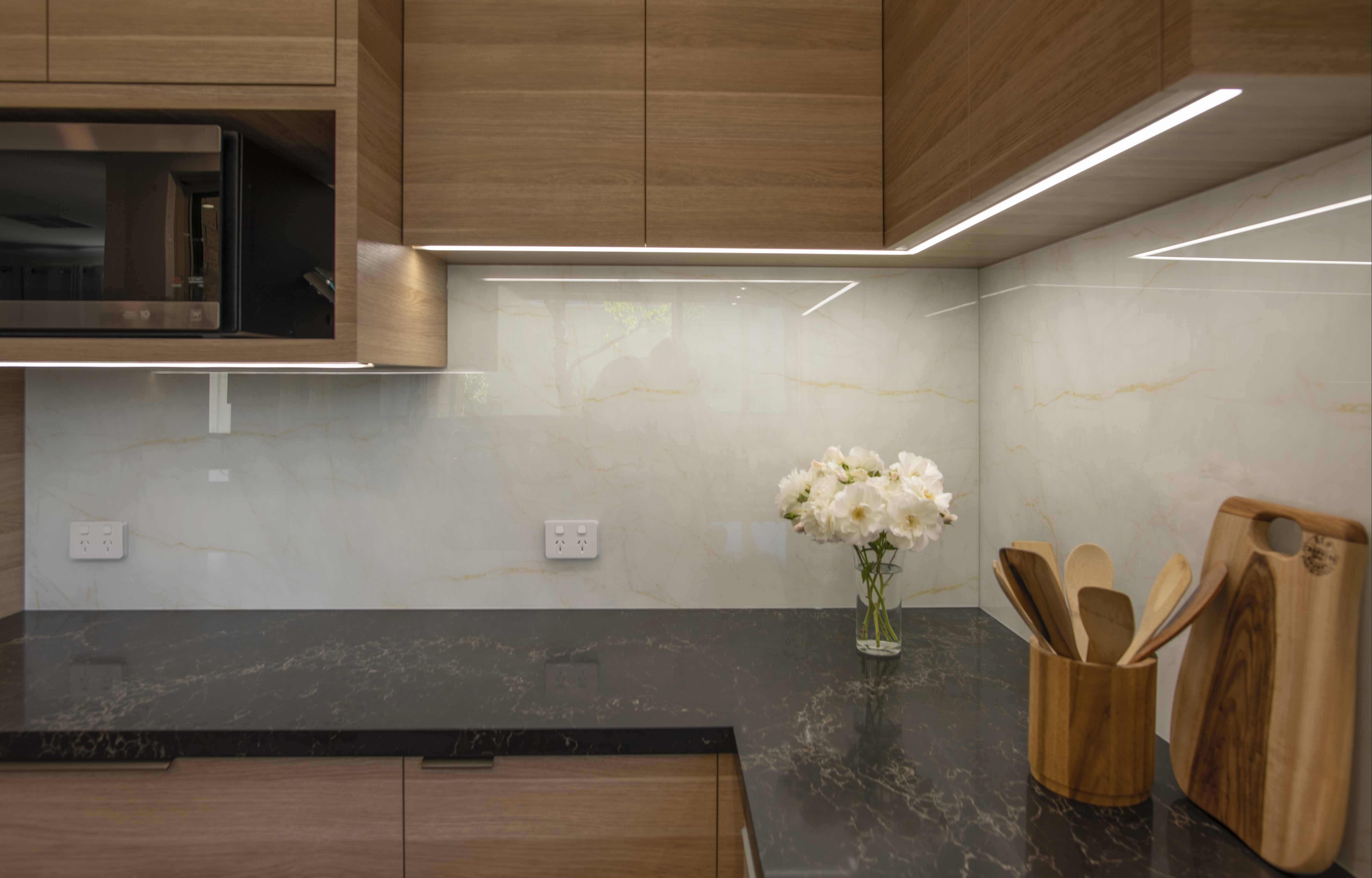
With so many splashback materials available in the market, choosing the right splashback can be a daunting task. One crucial factor to consider when selecting a splashback is its cleanability.
In this article, we’ll explore the easiest-to-clean splashback material and provide cleaning and maintenance tips for each category.
Understanding Splashbacks
What are Splashbacks?
Splashbacks, or backsplashes, are an essential component of any modern kitchen or bathroom. These protective panels are installed behind sinks, cooktops and work surfaces in modern kitchens to prevent water damage, grease stains and food splatters from ruining the kitchen walls and can also be used as a focal point or feature wall in kitchens and bathrooms.
When it comes to kitchen splashback materials, there are several options available, including glass, stainless steel, tiles and acrylic, with other splashback materials also available such as mirrored splashbacks. A glass splashback is a popular choice because they are easy to clean, extremely hygienic and come in a variety of colors and patterns to suit any design aesthetic. A stainless steel splashback is also a great option because they are durable, heat-resistant and add a sleek, modern look to any kitchen or bathroom.
Why are Splashbacks Important?
Kitchen splashbacks play a crucial role in protecting the walls from moisture damage and stains. Without adequate protection, water can seep into the walls, leading to mold and mildew growth. This can cause significant health problems, especially for individuals with respiratory issues.
Aside from their protective function, splashbacks are also a decorative element and contribute significantly to the overall aesthetic appeal of the space. They add a touch of style and elegance to any kitchen or bathroom, creating a clean, modern, and hygienic environment.
Furthermore, splashbacks are easy to clean and maintain, making them a practical choice for busy households. Unlike traditional painted walls, splashbacks can be wiped down quickly with a damp cloth, removing any dirt, grease, or food residue.
Overall, splashbacks are an essential investment for any homeowner looking to protect their walls, add style to their space, and create a clean, hygienic environment. With a range of materials, colors, and patterns available, there is a splashback to suit every kitchen design aesthetic and budget.
Factors to Consider When Choosing a Kitchen Splashback
When selecting the right splashback, you need to take into account several factors such as material, texture and finish, color and pattern, ease of installation, and more. Let’s dive deeper into these factors to help you make an informed decision.
Splashback Material
The material you choose for your splashback will impact its durability, cleanability, and overall aesthetic appeal.
Glass is a popular choice for splashbacks because it’s easy to clean and maintain. It’s also extremely versatile, allowing you to choose from a range of colors and patterns.
Acrylic is another option that’s relatively easy to install and comes in a variety of colors and finishes.
Stainless steel is a durable and modern option, with many hygienic qualities that make it ideal for commercial kitchens, but it can be prone to scratches and fingerprints.
Ceramic and porcelain tiles are a classic choice that’s easy to clean and comes in a range of colors and patterns.
Natural stones like marble and granite are luxurious options that add a touch of elegance to your space, but they can be expensive and require professional installation.
Texture and Finish
The texture and finish of the splashback will determine how easy it is to clean and maintain.
A surface with a matte finish could absorb water and become more challenging to clean, while a shiny surface could be easier to wipe down. Textured finishes, like a hammered or brushed finish, can add depth and dimension to your splashback. It’s essential to choose a texture and finish that complement your style and enhance the overall visual appeal of the space.
Color and Pattern
The color and pattern of the splashback play a critical role in enhancing the overall aesthetic appeal of the space. If you have neutral cabinets and countertops, a bold splashback can add a pop of color and personality to your kitchen.
On the other hand, if you have colorful cabinets and countertops, a neutral splashback can balance out the space. You could opt for a single color or create a unique pattern to make your space stand out. Subway tiles are a popular choice for creating a classic and timeless look, while mosaic tiles can add a playful and eclectic touch to your space.
Ease of Installation
The ease of installation is also an essential factor to consider.
Some materials require professional installation, while others could be DIY projects. Acrylic and glass splashbacks are relatively easy to install and can be done as a DIY project. Stainless steel and natural stone, on the other hand, require professional installation due to their weight and complexity.
It’s crucial to consider the cost of installation, especially if you’re on a tight budget. Additionally, consider the time it takes to install the splashback, as some materials may require more time and effort than others.
Maintenance
Maintenance is another crucial factor to consider when choosing a splashback.
Some materials, like glass and acrylic, are easy to clean and maintain. Others, like natural stone, require regular sealing and cleaning to make them stain resistant and prevent damage. It’s essential to choose a material that fits your lifestyle and maintenance needs. If you have a busy household with children and pets, you may want to opt for a material that’s easy to clean and maintain.
Budget
Your budget is another critical factor to consider when choosing a splashback.
Some materials, like natural stone, can be expensive, while others, like glass and acrylic, are more affordable and a cost effective alternative. Additionally, consider the cost of installation and any additional materials or tools you may need. It’s important to choose a material that fits your budget without compromising on quality or style.
By considering these factors, you can choose the perfect splashback for your space that’s both functional and stylish.
Comparing Different Splashback Materials
Glass Splashbacks
Glass splashbacks are sleek, modern, and have a smooth, non-porous surface that doesn’t let water or food residue seep in. They are durable, easy to clean, and come in a wide range of colors and patterns. Toughened glass splashbacks are also heat-resistant and can withstand high temperatures due to using toughened safety glass, making them ideal for behind the cooktop.
Acrylic Splashbacks
Acrylic splashbacks are lightweight, easy to install and come in a wide range of colors and patterns. They are also resistant to heat and impact and are easy to clean and maintain. However, acrylic could scratch quickly and harsh cleaners could damage the surface.
Stainless Steel Splashbacks
Stainless steel splashbacks are durable, easy to clean and have a sleek, modern look. They are also resistant to heat, making them ideal for use behind the cooktop. However, they could easily scratch and dent and fingerprints could be visible on the surface.
Ceramic and Porcelain Tile Splashbacks
Ceramic and porcelain tile splashbacks are a budget-friendly option that’s easy to clean and maintain. A tile splashback comes in a wide range of colors and patterns, and you could create unique designs to make your space stand out. However, ceramic and porcelain splashback tiles could chip or crack and grout lines could be challenging to clean.
Natural Stone Splashbacks
Natural stone splashbacks, such as marble or granite, have a luxurious and elegant appeal that could enhance the overall aesthetic appeal of the space. However, a natural stone splashback could be expensive and some could stain or etch easily if exposed to acidic substances such as lemon or vinegar. Natural stones also require periodic sealing to protect them from moisture damage.
Cleaning and Maintenance Tips for Splashbacks
General Cleaning Tips
To keep your splashback clean, you need to wipe it down regularly with a soft cloth and a mild cleaner. Avoid using abrasive cleaners or scourers that could scratch or damage the surface. After cleaning, rinse the splashback with water and dry it with a clean cloth to prevent water stains.
Material-Specific Cleaning Tips
Each material requires specific cleaning and maintenance techniques to keep it in top condition. For example:
- Glass splashbacks require a glass cleaner and a lint-free cloth to clean. Avoid using abrasive cleaners or scourers that could scratch the surface.
- Acrylic could scratch easily, so it’s crucial to use a soft cloth and a mild cleaner to clean them. Avoid using harsh cleaners or scourers that could damage the surface.
- Stainless steel splashbacks require a non-abrasive cleaner and a soft cloth to clean. After cleaning, rinse the surface with water and dry it with a clean cloth to prevent water stains.
- A ceramic or porcelain tiled splashback requires a tile cleaner and a soft brush to clean. Avoid using abrasive cleaners on a tiled kitchen splashback that could damage the surface or grout lines.
- Natural stone splashbacks require periodic sealing to protect them from moisture damage. Use a non-abrasive cleaner and a soft cloth to clean them and avoid using acidic cleaners that could etch the surface.
Preventing Stains and Damage
Preventing stains and damage is crucial to extend the life of your splashback. Some preventive measures include:
- Wipe down any spills or splatters as soon as they happen to prevent stains from setting in.
- Use a cutting board to chop food instead of cutting directly on the splashback.
- Avoid placing hot pans directly on the splashback to prevent heat damage.
Conclusion
Choosing the right splashback is essential for maintaining a clean, hygienic, and visually appealing kitchen or bathroom.
Glass, acrylic, stainless steel, porcelain and ceramic tiles, and natural stones are all excellent options, each with its unique benefits and drawbacks. With the right cleaning and maintenance techniques, you can keep your splashback looking new and shining for years to come.



